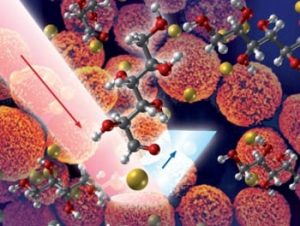Biosensing is one of the most prominent application fields of modern plasmonics. Modern nanofabrication schemes and other methodological advances enable new fascinating possibilities in this emerging scientific area.
Plasmonics is a steadily developing field that offers really fascinating promises not only for fundamental science but also for a wide range of potential applications. One of the most prominent subjects is the area of biosensing – making use of the high-field confinement offered by surface plasmon modes – a success story that started with the discovery of surface-enhanced Raman scattering. New sophisticated nanofabrication schemes open up fascinating possibilities of tailoring und structuring optical fields on the subwavelength scale to create optimized conditions for the interaction with molecular species.
The recent Topical Issue of Annalen der Physik provides a snapshot of the variety of research in this fascinating area of modern plasmonics. Renowned European scientists function as the editors of the issue: Stefan Maier, co-director of the College’s Centre for Plasmonics and Metamaterials Imperial College London (UK), Mikael Käll, head of the Division of Bionanophotonics at the Department of Applied Physics at Chalmers University of Technology in Gothenburg (Sweden), and Liberato Manna, head of the Nanochemistry Department at the Istituto Italiano di Tecnologia in Genoa (Italy).
 A whole wealth of information throughout the field of plasmonics is offered by the special issue, starting with reports on nanofabrication techniques. A review article describes nanostructures for surface-enhanced Raman scattering. Various nanoplasmonic devices can be fabricated using top-down methods such as electron beam lithography, electroplating and focused ion beam techniques. Theoretical simulations are presented on model nanostructures in order to understand the electrical field distribution.
A whole wealth of information throughout the field of plasmonics is offered by the special issue, starting with reports on nanofabrication techniques. A review article describes nanostructures for surface-enhanced Raman scattering. Various nanoplasmonic devices can be fabricated using top-down methods such as electron beam lithography, electroplating and focused ion beam techniques. Theoretical simulations are presented on model nanostructures in order to understand the electrical field distribution.
A second review deals with the concepts and implementations of phase-sensitive surface plasmon resonance (SPR) biosensors, providing a tutorial on phase detection in SPR sensing. Conventional SPR sensors have been extensively explored and applied, but still lacks sensitivity for the detection of relatively small and low copy number compounds. Phase-sensitive SPR has recently emerged as an upgrade of this technology, which enables to solve the sensitivity problem. Annalen der Physik offer free access to both review articles.
The primary research articles included can be loosely divided into work reporting advances in sensing techniques and methodologies, from waveguide-based surface plasmon-polariton sensing, fiberoptic sensors, to comparisons between localized surface plasmon resonance with conventional Fabry-Pérot-type sensors, and into work primarily dealing with materials related aspects, focusing particularly on how surface quality and controlled surface modifications affect sensing performance. The issue closes with a Rapid Research Letter on laser-assisted substrate generation for surface enhanced Raman scattering.

















